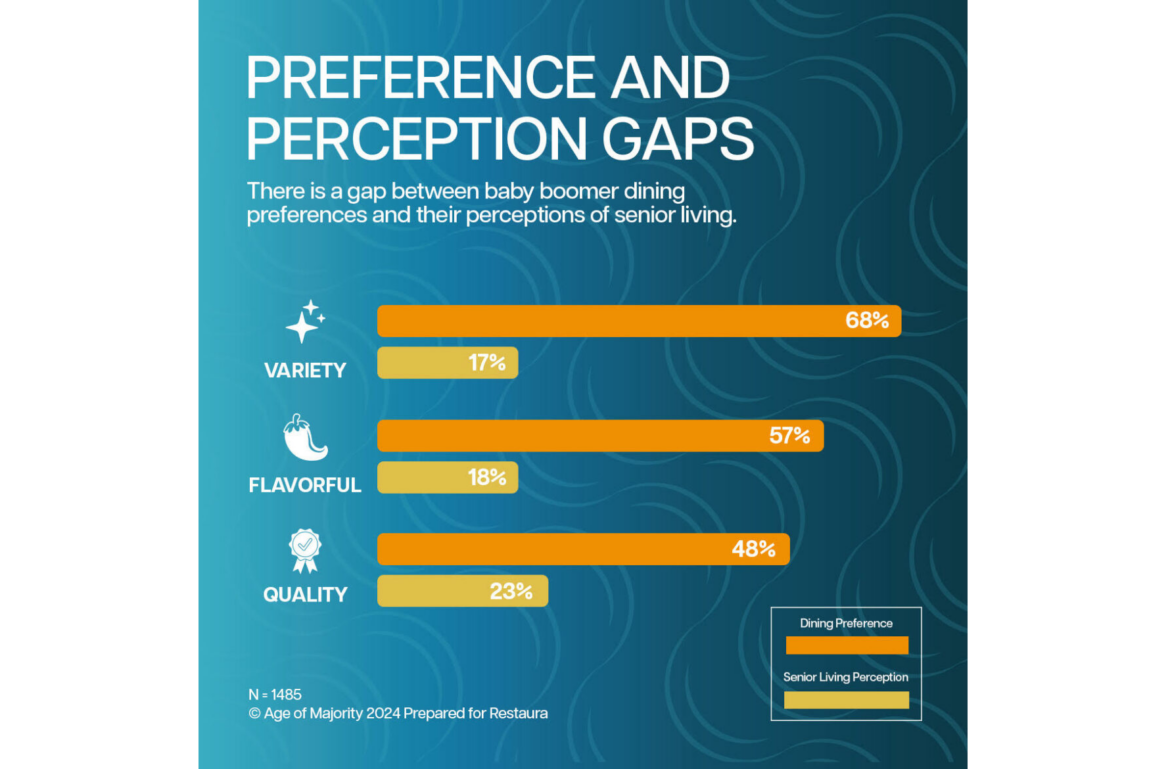BOSTON — Older adults aspire to be “ageless wonders” and prioritize food and nutrition as the No. 1 factor affecting their health and well-being, according to a newly released survey.
The majority of today’s baby boomer population (69 percent) plan to age in place, the “Great Expectations” survey conducted by Age of Majority for Restaura found. A key factor in their desire to stay in their homes could be the significant gap the survey uncovered between how and what they like to eat and the perceived ability of senior living communities to meet their dining needs.
“Nowhere is the desire for independence more evident than in the ability to choose what and where we eat,” says Richard Schenkel, founder and executive chairman of Boston-based Restaura, a new dining services provider serving senior living communities.
“Boomers are the first instant-gratification aging generation. They expect to be able to enjoy their version of great food anywhere, anytime, and importantly, they understand the impact of nutrition on longevity,” adds Schenkel.
Some 1,485 adults between the ages of 55 and 96 were surveyed to better understand the importance of food and dining in their later-life residential decisions. Age of Majority, a consulting firm specializing in the 55-plus market, conducted the online survey between Aug. 21 and Aug. 23.
“This survey was a first of its kind that we’re aware of,” says Joe Cuticelli, CEO of Restaura. “We wanted to really understand the perceptions of senior living dining from the potential resident population. Separately, we also took time to do quantitative research with 100 senior living community leaders to understand opportunities and challenges from their perspectives. Together the results are invaluable in the conversations we’re having with operators.”
Over one-third of older adults described themselves as “ageless wonders” who want to stay healthy proactively for as long as possible. This empowered older cohort has the spending power to live and eat where they want. Today’s aging population holds over 80 percent of the wealth in the U.S. and represents $8.3 trillion in annual economic activity, according to Restaura.
Freedom of Choice Matters
The research found that nearly seven in 10 respondents (68 percent) look for variety in meal options that cater to their individual tastes and preferences when choosing how they dine, yet only 17 percent are very confident that senior living communities could deliver the dining variety they expect.
If they were considering a move to a senior living community, respondents would prioritize flexibility (65 percent) to prepare their own meals, dine out, or order takeout over access to multiple dining venues (21 percent).
“The lure of aging in place includes the flexibility to eat when and what you want. Active aging and senior living communities need to adapt to this mindset while also delivering high-quality, flavorful foods,” emphasizes Cuticelli. “It’s a tall order, but we’ve seen a similar evolution in other sectors, such as campus and airport dining.”
Cuticelli notes that, while the senior living industry has made transformational strides with intergenerational and active aging community designs, evolving the current approach to culinary experiences may be the missing link.
Taste Explorers
The survey asked respondents to characterize what they like to eat. In a nod to changing stereotypes, 32 percent of older adults described themselves as “food explorers” who are very adventurous in trying new tastes and flavors. They look for flavorful, well-seasoned dishes that use fresh, minimally processed ingredients, as well as low-sugar, low-sodium, and high-protein foods.
Conversely, only 16 percent indicated that medical dietary considerations are important in picking what they eat, even though 41 percent were very confident senior living would offer that option.
Filling a Void
The MIT AgeLab studies consumer-centered systems to understand the challenges and opportunities of longevity and emerging generational lifestyles. Founder and director Dr. Joe Coughlin has explored how global demographics, technology, and changing behaviors are transforming business and society. This work has identified the critical need for the active aging industry to shift from an infrastructure primarily focused on caregiving to one that offers concierge-type services and experiences.
Against that backdrop, Restaura was recently founded to disrupt the $45.1 billion foodservice contracting business and to provide senior living and active adult community residents with the variety and choices they have grown accustomed to in their home communities.
Restaura leverages state-of-the-art technology, data analytics and forward-thinking strategies to craft dining experiences and business solutions tailored to the needs of its clients.
Biggest Survey Takeaways
“I was pleasantly surprised to see that 69 percent of respondents ranked food quality as very important to their choice of a community — even higher than dining options, says Cuticelli. “But I was disappointed that restaurant quality food was not something associated with senior living. Clearly there are opportunities for the industry as a whole and for Restaura.”

